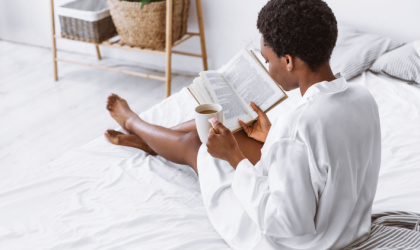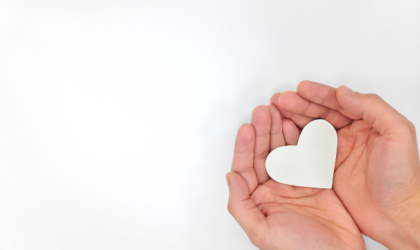
By now, most of us recognise the importance of self-care. And there are many tools worthy of their place in your arsenal. One of those tools is aromatherapy – the practice of using essential oils to support health.
Drawing on elements of the natural world – most of which have been used in traditional applications for thousands of years – aromatherapy invites you to relax and unwind amidst the chaos of the modern world.
Here, we take a look at the best ways to infuse your life with more aromatherapy.
What are the best essential oils for relaxation?
From lavender to clary sage, there’s no shortage of soothing essential oils to support relaxation and relieve stress when you need it.
Lavender
Lavender is the most popular essential oil for good reason. Fresh and floral, this calming fragrance is known for its anxiolytic (anti-anxiety) and restorative properties, making it a firm favourite for general wellbeing.
Try it: Lavender essential oil
Ylang-Ylang
Sweet and floral, ylang-ylang has long been used for rest and relaxation. Research suggests it may even help decrease blood pressure (1).
Try it: Sensual Blend
Clary sage
Native to the Mediterranean basin, clary sage is a popular choice to buffer against stress due to its effect on cortisol, the stress hormone (2).
Try it: Relaxing Blend
Geranium
Warm and uplifting, geranium is known to have a calming and balancing effect on the body and mind.
Try it: Relaxing Blend
Chamomile
Many people fix themselves a cup of chamomile tea before bed to help them sleep. Chamomile essential oil is no different. Known for its relaxing, sedative qualities, chamomile is the perfect addition to support rest and relieve stress.
Try it: Rose Geranium & Chamomile
Rose
Rose essential oil doesn’t just have a deliciously floral aroma, it’s also packed with soothing properties. One study involving over 100 pregnant women found that rose essential oil significantly lowered anxiety levels during labour (3).
Try it: Rose Geranium & Chamomile
How can I use aromatherapy?
Aromatherapy is a versatile and convenient self-care tool to improve your health and wellbeing. And there are countless ways to weave more of it into your daily life.
It’s important to mention, however, that you should never use essential oils neat on your skin. Always dilute them in a carrier oil, like grapeseed. As a general rule, aim for one drop of essential oil per one teaspoon of carrier oil.
Incorporate into massage
Nothing compliments massage better than aromatherapy. Adding essential oils creates the perfect alchemy for relaxation and rejuvenation.
If you have a willing masseuse at home, it can be an affordable way to enjoy some stress relief regularly. If not, paying a professional can be a worthy investment.
You can also give yourself an aromatherapy massage or facial. Simply dilute a few drops of your favourite essential oil in a carrier oil and massage over your face, collarbones, hands, feet, and anywhere else that needs a bit of love.
Diffuse
Safe and easy to use, aromatherapy diffusers are a great choice for essential oil lovers. They disperse natural fragrances into the air, filling your home with beautifully scented, relaxing aromas.
You can place a diffuser on your work desk, incorporate it into your yoga practice, or use it as you unwind before bed. Whatever your wellness needs, essential oil diffusers offer a sensory escape to nurture your mind, body, and soul.
Each diffuser works is unique, so always follow the instructions on how to use it.
Use in meditation
Essential oils can enhance your meditation practice by providing a focal point, helping you feel more grounded and inviting full-body relaxation.
You could diffuse essential oils while meditating, or add a few drops to a base carrier oil and massage onto your pulse points – behind the ears, third eye (around the middle of the forehead), on the wrists, or at the base of the throat – before your practice.
Make a pillow spray
Aromatherapy and sleep have always been good friends. Essential oils, like lavender, have long been recognised for their ability to calm the nervous system before bed.
To help you drift into restful, high-quality sleep every night, consider making a DIY pillow spray.
Ingredients
-
30ml witch hazel
-
30ml distilled water
-
20-30 drops of your favourite essential oils
-
60ml glass spray bottle
-
Funnel
Method
-
Using the funnel, pour the witch hazel, water, and essential oils into your bottle
-
Tighten the cap and swirl around to combine
-
To use, spray 3-4 times on your pillow before bed
Apply to pulse points
To keep you calm and centred throughout the day, you may wish to dilute a soothing blend of essential oils in a carrier oil and apply the mixture to your pulse points, like your temples and wrists.
You could even use a pulse point roller ball – perfect to keep in pockets and handbags – when you’re out and about.
Add to a warm bath
Essential oils take your warm bath to the next level, dialling up the stress-relieving, mind-soothing, zen-activating benefits.
A word of warning: never add essential oils directly to your bath water. Oil and water don’t mix. Essential oils aren’t water-soluble, meaning small drops of oil may cling to your skin when you climb into the bath, which could irritate your skin.
Always dilute essential oils in a carrier oil first. For a single bath, 3-6 drops of your favourite essential oils in a tablespoon of carrier oil should be enough to create a therapeutic bathing experience. Always read the label before use as some essential oils are not suitable for using in this way.
For an extra sprinkle of relaxation, you could even add Epsom or Himalayan salts to your tub.
Simply inhale
For on-the-go relaxation, consider keeping essential oils in your bag and inhaling them throughout the day. Just don’t let the undiluted oil come into contact with your skin.
Find out more
If you found this article on aromatherapy and relaxation helpful, you can find similar guidance on Nutrition Buzz. Alternatively, please get in touch with our team of expert Nutrition Advisors, who are on hand to provide free, confidential advice via email, phone, and Live Chat.
References:
-
Hongratanaworakit T, Buchbauer G. (2006) Relaxing effect of ylang ylang oil on humans after transdermal absorption. Phytother Res. 20(9):758-63.
-
Lee KB, Cho E, Kang YS. (2014) Changes in 5-hydroxytryptamine and cortisol plasma levels in menopausal women after inhalation of clary sage oil. Phytother Res. 28(11):1599-605.
-
Kheirkhah M, Vali Pour NS, Nisani L, Haghani H. (2014) Comparing the effects of aromatherapy with rose oils and warm foot bath on anxiety in the first stage of labor in nulliparous women. Iran Red Crescent Med J. 16(9):e14455.
Related Posts

Olivia
Olivia Salter has always been an avid health nut. After graduating from the University of Bristol, she began working for a nutritional consultancy where she discovered her passion for all things wellness-related. There, she executed much of the company’s content marketing strategy and found her niche in health writing, publishing articles in Women’s Health, Mind Body Green, Thrive and Psychologies.
View More



